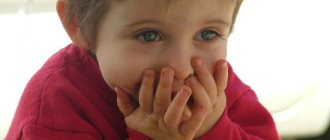The state of general speech underdevelopment (GSD) is characterized by a violation of all aspects of the formation of speech skills.
Its main distinguishing feature is the presence of problems both with the sound side (pronunciation), and with lexical and grammatical aspects. At the same time, children with general speech underdevelopment do not have hearing or intellectual impairments. Distinctive features of OHP:
- The presence of problems both with the pronunciation of sounds and with the skills of coherent expressive speech, mastering the rules of grammatical structure and a poor active vocabulary.
- Hearing is not impaired. A specialist check is required.
- Primary intelligence is normal. That is, a child at birth does not have a diagnosis of “mental retardation,” etc. However, it is worth keeping in mind that long-term uncorrected mental retardation can also lead to mental retardation.
It is possible to talk about the presence of general speech underdevelopment in a child only after 3-4 years. Until this time, children develop differently and “have the right” to some deviations from average norms. Everyone has their own pace of speech formation. But after 3, it’s worth paying attention to how the child speaks. It is quite possible that he needs the help of a speech therapist.
The manifestation of OHP in children is expressed differently based on their depth of impairment.
General speech underdevelopment level 1
A violation of this degree means an almost complete absence of speech in the child. Problems are visible to what is called the “naked eye.”
What does it show:
- A child's active vocabulary is very poor. To communicate, he uses mainly babbling words, the first syllables of words, and onomatopoeia. At the same time, he is not at all averse to communicating, but in “his” language. A cat means “meow”, “beep” can mean a car, a train, or the process of driving itself.
- Gestures and facial expressions are widely used. They are always appropriate, carry a specific meaning and, in general, help the child communicate.
- Simple sentences either simply do not exist in the child’s speech, or may consist of two amorphous words combined in meaning. “Meow bee bee” during the game will mean that the cat drove the car. “Woof di” means both the dog is walking and the dog is running.
- At the same time, the passive vocabulary significantly exceeds the active one. The child understands spoken speech to a much greater extent than he can say himself.
- Compound words (consisting of several syllables) are abbreviated. For example, bus sounds like "abas" or "atobu". This indicates that phonemic hearing is unformed, that is, the child does not distinguish individual sounds well.
What influences the proper development of speech?
There are two groups of factors that influence speech development:
- Biological.
- Social.
The first include various pathogenic factors that can harm proper development: complex intrauterine development, brain infections and injuries, hearing impairment, heredity.
The second group is a combination of the child’s internal development processes and external conditions that are specific to each age stage. For example, the early separation of a baby from his mother sometimes causes emotional instability, impulsiveness, and behavioral disturbances. And this, in turn, leads to speech disorders.
Good conversation is influenced by examples and role models. The child first hears how they speak in the family, so he begins to try it himself. In order to correctly assimilate words during play activities, the child first accumulates impressions - this is the basis for future images and connections with them in speech. The development of gross motor skills also affects the correctness of conversation. The development of speech skills is influenced by the language a child learns to speak. An attempt to master several languages at once may slightly slow down a child’s development; his speech may develop more slowly.
In no case should a child be punished for mistakes in speech, teased or corrected with irritation. This can cause withdrawal and reluctance to try further.
The role of the family in the formation of speech reserve is key. Parents study poems and songs, recitations with their child, teach the child to speak at the right speed, and respond to his attempts to carry on a conversation.
Proper speech development is promoted by:
- Emotionally positive environment;
- Peace of mind in the family;
- Moderate sound communication between loved ones (no shouting);
- Feeling of security in the family;
- Patience of parents towards the child;
- Sensitive and friendly behavior of kindergarten teachers.
General speech underdevelopment level 2
The main striking difference from level 1 is the constant presence in the child’s speech of a certain number of commonly used words, although not yet pronounced very correctly. At the same time, the beginnings of the formation of a grammatical connection between words are noticeable, although not yet permanent.
What to pay attention to:
- The child always uses the same word, denoting a specific object or action in a distorted form. For example, apple will always sound like “lyabako” in any context.
- The active dictionary is quite poor. The child does not know words denoting the characteristics of an object (shape, its individual parts).
- There is no skill in combining objects into groups (a spoon, plate, pan are utensils). Objects that are similar in some way can be called in one word.
- Sound pronunciation is also far behind. The child pronounces many sounds poorly.
- A characteristic feature of level 2 OHP is the appearance in speech of the rudiments of a grammatical change in spoken words depending on the number. However, the child can only cope with simple words even if the ending is stressed (go - goUt). Moreover, this process is unstable and does not always manifest itself.
- Simple sentences are actively used in speech, but the words in them are not consistent with each other. For example, “papa pitya” - dad came, “guyai gokam” - walked on the hill, etc.
- Prepositions in speech may be completely missed or used incorrectly.
- A coherent story - based on a picture or with the help of an adult's questions - is already obtained, in contrast to the state at level 1 OHP, but it is very limited. Basically, the child uses two-syllable, inconsistent sentences consisting of a subject and a predicate. “Guyai gokam. Videy seg. Ipiy segika." (Walked on a hill, saw snow, made a snowman).
- The syllabic structure of polysyllabic words is disrupted. As a rule, syllables are not only distorted due to incorrect pronunciation, but also rearranged and simply thrown out. (Boots are “bokiti”, people are “tevek”).
What is the norm of speech development
Pediatricians, neurologists, speech therapists, and teachers rely on the norms of speech development when working with children. These include progress in speaking and emotional development characteristic of each individual period of a child’s life. From birth, specialists observe the baby, how he learns to respond to the voice of an adult, reacts to speech from the outside, begins to “walk”, babble and gradually comes to the full process of speaking.
Psychologists warn that it is not worth relying fully on WHO criteria. Each child is an individual, a person with distinctive qualities. One baby can speak at 2 years old, another at 3, and this will be the norm. The main thing is to respond in a timely manner to the delay in speech development, work with the child, and undergo an examination. Often problems lie in the character traits of the baby.
General speech underdevelopment level 3
This stage is characterized mainly by a lag in terms of grammatical and phonemic development of speech. Expressive speech is quite active, the child constructs detailed phrases and uses a large vocabulary.
Problem points:
- Communication with others is mainly in the presence of parents, who act as assistant translators.
- Unstable pronunciation of sounds that the child has learned to pronounce separately. In independent speech they still sound unclear.
- Sounds that are difficult to pronounce are replaced by others. Whistling, hissing, sonorant and affricates are more difficult to master. One sound can replace several at once. For example, the soft “s” often plays different roles (“syanki” - sledge, “syuba” - “fur coat”, “syapina” - “scratch”).
- The active vocabulary is noticeably expanding. However, the child does not yet know the little-used vocabulary. It is noticeable that in his speech he uses mainly words of everyday meaning, which he often hears around.
- The grammatical connection of words in sentences, as they say, leaves much to be desired, but at the same time the child confidently approaches the construction of complex and complex constructions. (“Papa wrote and pyinesya Mise padaik, how Misya haase behave yourself” - Dad came and brought Misha a gift, BECAUSE Misha behaved well. As we see, a complex construction is already “asking for the tongue”, but the grammatical agreement of words is not yet given ).
- From such incorrectly formed sentences, the child can already compose a story. Sentences will still only describe a specific sequence of actions, but there will no longer be a problem with constructing phrases.
- A characteristic feature is the inconsistency of grammatical errors. That is, in one case, a child can correctly coordinate words with each other, but in another, use the wrong form.
- There are difficulties in correctly agreeing nouns with numerals. For example, “three catsAM” - three cats, “many sparrows” - many sparrows.
- The lag in the formation of phonemic abilities is manifested in errors when pronouncing “difficult” words (“gynasts” - gymnasts), in the presence of problems in analysis and synthesis (the child finds it difficult to find words starting with a specific letter). This, among other things, delays the child’s readiness to succeed in school.
www.Logopedy.ru
With normal speech development, children by the age of 5 freely use expanded phrasal speech and various constructions of complex sentences. They have a sufficient vocabulary and master the skills of word formation and inflection. By this time, correct sound pronunciation and readiness for sound analysis and synthesis are finally formed.
However, not in all cases these processes proceed well: in some children, even with normal hearing and intelligence, the formation of each of the components of the language is sharply delayed: phonetics, vocabulary, grammar. This violation was first established by R.E. Levina and is defined as a general underdevelopment of speech.
All children with general speech underdevelopment always have a violation of sound pronunciation, underdevelopment of phonemic hearing, and a pronounced lag in the formation of vocabulary and grammatical structure.
General speech underdevelopment can manifest itself to varying degrees. Therefore, there are three levels of speech development.
I of speech development is characterized by the absence of speech (the so-called “speechless children”).
Children at this level use mainly babbling words, onomatopoeia, individual nouns and verbs of everyday content, and fragments of babbling sentences, the sound design of which is blurry, unclear and extremely unstable, to communicate. Often the child reinforces his “statements” with facial expressions and gestures. A similar state of speech can be observed in mentally retarded children. However, children with primary speech underdevelopment have a number of features that allow them to be distinguished from oligophrenic children (mentally retarded children). This primarily refers to the volume of the so-called passive vocabulary, which significantly exceeds the active one. In mentally retarded children, no such difference is observed. Further, in contrast to oligophrenic children, children with general speech underdevelopment use differentiated gestures and expressive facial expressions to express their thoughts. They are characterized, on the one hand, by great initiative in speech search in the communication process, and on the other hand, by sufficient criticality of their speech.
Thus, despite the similarity of the speech state, the prognosis for speech compensation and intellectual development in these children is ambiguous.
A significant limitation of the active vocabulary is manifested in the fact that the child uses the same babbling word or sound combination to designate several different concepts (“bibi” - airplane, dump truck, steamship; “bobo” - hurts, lubricate, give an injection). There is also a replacement of the names of actions with the names of objects and vice versa (“adas” - pencil, draw, write; “tui” - sit, chair).
The use of one-word sentences is typical. As N.S. Zhukova notes, the period of a one-word sentence, a sentence made from amorphous root words, can also be observed during normal speech development of the child. However, it is dominant only for 5-6 months and includes a small number of words. In case of severe underdevelopment of speech, this period is delayed for a long time. Children with normal speech development begin early to use grammatical connections of words (“give kheba” - give bread), which can coexist with formless constructions, gradually displacing them. In children with general speech underdevelopment, there is an expansion of the sentence volume to 2-4 words, but at the same time the syntactic constructions remain completely incorrectly formed (“Matik tide thuya” - The boy is sitting on a chair). These phenomena are never observed during normal speech development.
Low speech abilities of children are accompanied by poor life experience and insufficiently differentiated ideas about the surrounding life (especially in the field of natural phenomena).
There is instability in the pronunciation of sounds and their diffuseness. In children's speech, 1-2 syllable words predominate. When trying to reproduce a more complex syllable structure, the number of syllables is reduced to 2 - 3 (“avat” - crib, “amida” - pyramid, “tika” - electric train). Phonemic perception is grossly impaired, difficulties arise even when selecting words that are similar in name but different in meaning (hammer - milk, digs - rolls - bathes). Tasks on the sound analysis of words are incomprehensible to children of this level.
Do you like the article? Tell your friends!
The transition to the second level of speech development (the beginnings of common speech) is marked by the fact that, in addition to gestures and babbling words, although distorted, but fairly constant common words appear (“Alyazai. Alyazai children kill. Kaputn, lidome, lyabaka. Litya give the earth.” - Harvest. Children harvesting crops. Cabbages, tomatoes, apples. Leaves falling to the ground).
At the same time, a distinction is made between some grammatical forms. However, this occurs only in relation to words with stressed endings (table - tables; whines - sing) and relating only to some grammatical categories. This process is still quite unstable, and gross underdevelopment of speech in these children is quite pronounced.
Children's statements are usually poor; the child is limited to listing directly perceived objects and actions.
The story based on the picture and the questions is built primitively, on short, although grammatically more correct, phrases than for children of the first level. At the same time, insufficient development of the grammatical structure of speech is easily detected when the speech material becomes more complex or when the need arises to use words and phrases that the child rarely uses in everyday life.
The forms of number, gender and case for such children essentially do not have a meaningful function. The word change is random in nature, and therefore many different errors are made when using it (“I’m playing mint” - I’m playing with a ball).
Words are often used in a narrow sense, the level of verbal generalization is very low. The same word can be used to name many objects that are similar in shape, purpose or other characteristics (ant, fly, spider, beetle - in one situation - one of these words, in another - another; a cup, a glass is denoted by any of these words). The limited vocabulary is confirmed by ignorance of many words denoting parts of an object (branches, trunk, roots of a tree), dishes (dish, tray, mug), vehicles (helicopter, motor boat), baby animals (baby squirrel, hedgehog, little fox), etc.
There is a lag in the use of words-attributes of objects denoting shape, color, material. Substitutions of word names often appear due to the commonality of situations (cuts - tears, sharpens - cuts). During a special examination, gross errors in the use of grammatical forms are noted:
1) replacement of case endings (“rolled-gokam” - rides on a slide);
2) errors in the use of number forms and gender of verbs (“Kolya pityala” - Kolya wrote); when changing nouns by numbers (“da pamidka” - two pyramids, “dv kafi” - two cabinets);
3) lack of agreement of adjectives with nouns, numerals with nouns (“asin adas” - red pencil, “asin eta” - red ribbon, “asin aso” - red wheel, “pat kuka” - five dolls, “tinya pato” - blue coat, “tinya cube” - blue cube, “tinya cat” - blue jacket).
Children make many mistakes when using prepositional constructions: often prepositions are omitted altogether, while the noun is used in its original form (“Kadas ladyt aepka” - The pencil lies in the box), prepositions can also be replaced (“The notebook has fallen and thawed” - The notebook fell from the table ).
Conjunctions and particles are rarely used in speech.
The pronunciation capabilities of children lag significantly behind the age norm: there is a violation in the pronunciation of soft and hard sounds, hissing, whistling, sonorant, voiced and voiceless (“tupans” - tulips, “Sina” - Zina, “tyava” - owl, etc. ); gross violations in the transmission of words of different syllabic composition. The most typical reduction in the number of syllables (“teviki” - snowmen).
When reproducing words, the sound content is grossly violated: rearrangements of syllables, sounds, replacement and assimilation of syllables, abbreviations of sounds when consonants coincide (“rotnik” - collar, “tena” - wall, “vimet” - bear) are noted.
An in-depth examination of children makes it easy to identify insufficient phonemic hearing, their unpreparedness to master the skills of sound analysis and synthesis (it is difficult for a child to correctly select a picture with a given sound, determine the position of a sound in a word, etc.). Under the influence of special correctional training, children move to a new - III level of speech development, which allows them to expand their verbal communication with others.
III of speech development is characterized by the presence of extensive phrasal speech with elements of lexico-grammatical and phonetic-phonemic underdevelopment.
Children of this level come into contact with others, but only in the presence of parents (educators) who make appropriate explanations (“Mom went aspak. And then she walked, little girl, there was a call. Then they didn’t beat aspalki. Then they sent me pack.” - I went with my mother to the zoo. And then she went, where is the cage, there is a monkey. Then we weren’t at the zoo. Then we went to the park).
Free communication is extremely difficult. Even those sounds that children can pronounce correctly do not sound clearly enough in their independent speech.
Characteristic is the undifferentiated pronunciation of sounds (mainly whistling, hissing, affricates and sonorants), when one sound simultaneously replaces two or more sounds of a given phonetic group. For example, a child replaces with the sound s', which is not yet clearly pronounced, the sounds s (“syapogi” instead of boots), sh (“syuba” instead of a fur coat), ts (“syaplya” instead of a heron).
At the same time, at this stage, children already use all parts of speech, correctly use simple grammatical forms, try to build complex and complex sentences (“Kola sent a messenger to the forest, washed a little squirrel, and Kolya got a cat in the rear” - Kolya went into the forest, caught a small squirrel, and lived in Kolya’s cage).
The child’s pronunciation abilities improve (it is possible to identify correctly and incorrectly pronounced sounds, the nature of their violation), and the reproduction of words of different syllable structure and sound content. Children usually no longer find it difficult to name objects, actions, signs, qualities and states that are well known to them from life experience. They can freely talk about their family, themselves and comrades, the events of the surrounding life, write a short story (“The cat poshya kueuke. And now she wants to eat sypyatki. They run away. The cat is filthy kuitsa. Sypyatkakh mogo. Shama shtoit. Kuitsa choesha, she dirty cat" - The cat went to the chicken. And now she wants to eat chickens. They run away. The chicken drove the cat away. There are a lot of chickens. She stands on her own. The chicken is good, she drove the cat away).
However, a careful study of the state of all aspects of speech reveals a clear picture of underdevelopment of each of the components of the language system: vocabulary, grammar, phonetics.
In oral communication, children try to “bypass” words and expressions that are difficult for them. But if you put such children in conditions where it turns out to be necessary to use certain words and grammatical categories, gaps in speech development appear quite clearly.
Although children use extensive phrasal speech, they experience greater difficulties in independently composing sentences than their normally speaking peers.
Against the background of correct sentences, one can also find ungrammatical ones, which arise, as a rule, due to errors in coordination and management. These errors are not constant: the same grammatical form or category can be used both correctly and incorrectly in different situations.
Errors are also observed when constructing complex sentences with conjunctions and allied words (“Misha zyapyakal, the atom fell” - Misha cried because he fell). When making sentences based on a picture, children, often correctly naming the character and the action itself, do not include in the sentence the names of the objects used by the character.
Despite the significant quantitative growth of the vocabulary, a special examination of lexical meanings allows us to identify a number of specific shortcomings: complete ignorance of the meanings of a number of words (swamp, lake, stream, loop, straps, elbow, foot, gazebo, veranda, porch, etc.), inaccurate understanding and the use of a number of words (hem - sew up - cut, trim - cut out). Among the lexical errors the following stand out:
a) replacing the name of a part of an object with the name of the whole object (the dial is “watch”, the bottom is “teapot”);
b) replacing the names of professions with names of actions (ballerina - “aunt is dancing”, singer - “uncle is singing”, etc.);
c) replacing specific concepts with generic ones and vice versa (sparrow - “bird”; trees - “Christmas trees”);
d) interchange of characteristics (tall, wide, long - “big”, short - “small”).
In free expressions, children make little use of adjectives and adverbs denoting the characteristics and state of objects and methods of action.
Insufficient practical skill in using word formation methods impoverishes the ways of vocabulary accumulation and does not give the child the opportunity to distinguish the morphological elements of a word.
Many children often make mistakes in word formation. Thus, along with correctly formed words, non-normative ones appear (“stolenok” - table, “lily” - jug, “vaska” - vase). Such errors, as isolated ones, can normally occur in children at earlier stages of speech development and quickly disappear.
A large number of errors occur in the formation of relative adjectives with the meaning of correlation with food, materials, plants, etc. (“fluffy”, “puffy”, “downy” - scarf; “klyukin”, “klyukny”, “klyukonny” - jelly; “steklyashkin”, “glass” - glass, etc.).
Among the errors in grammatical formatting of speech, the most specific are the following:
a) incorrect agreement of adjectives with nouns in gender, number, case (“Books lie on large (large) tables” - Books lie on large tables);
b) incorrect agreement of numerals with nouns (“three bears” - three bears, “five fingers” - five fingers; “two pencils” - two pencils, etc.);
c) errors in the use of prepositions - omissions, substitutions, omissions (“We went to the store with mom and brother” - We went to the store with mom and brother; “The ball fell from the shelf” - The ball fell from the shelf);
d) errors in the use of plural case forms (“In the summer I was in the village with my grandmother. There is a river, a lot of trees, geese”).
The phonetic design of speech in children with level III speech development lags significantly behind the age norm: they continue to exhibit all types of sound pronunciation disorders (sigmatism, rhotacism, lambdacism, voicing and mitigation defects).
There are persistent errors in the sound filling of words, violations of the syllabic structure in the most difficult words (“Gynasts perform in the circus” - Gymnasts perform in the circus; “Topovotik is repairing the water drain” - Vodoprovodchit is repairing the water supply system; “Takiha tet tan” - The weaver is weaving fabric).
Insufficient development of phonemic hearing and perception leads to the fact that children do not independently develop readiness for sound analysis and synthesis of words, which subsequently does not allow them to successfully master literacy at school without the help of a speech therapist.
So, the totality of the listed gaps in the phonetic-phonemic and lexical-grammatical structure of a child’s speech serves as a serious obstacle to his mastering the program of a general kindergarten, and subsequently the program of a comprehensive school.
Filicheva T.B., Cheveleva N.A. Speech disorders in children. – M., 1993.
Other articles on the topic “general speech underdevelopment”:
- Physical development of children with special needs of preschool age
- Development of optical-spatial concepts in preschool children with OHP
- Speech development for children with special needs development using a wooden toy
| If you liked this article, share the link to the article with your friends and acquaintances on social media. networks using this button | If you have your own special opinion about the material presented, leave your comment in the form below |
Social commentary Cackle
Comprehensive diagnosis of the disease
It is important to involve different specialists in diagnosing speech underdevelopment. This is necessary to identify the cause of the disease. After all, it is important to treat it, and not the symptoms.
First of all, a neurologist, speech therapist, and neuropsychologist look at the baby. In some cases, you may need to consult a surgeon, dentist, otolaryngologist, or psychoneurologist.
But the leading role is given to the neurological examination. The doctor will assess the state of the nervous system and the location of the lesion - the form of the speech disorder depends on it. In conclusion, the neurologist indicates the cause of the disorder, its form, and focuses attention on the primary problem areas. All this data is subsequently used in diagnosis and correction by a speech therapist.
After consulting a neurologist - and in some cases other specialized specialists - the child is referred to a speech pathologist-speech pathologist. He studies the conclusions of his colleagues, supplements the anamnesis with the words of the parents, and then examines the child’s speech apparatus, studying the features of his sound pronunciation.
Then the speech therapist communicates with the little patient. In the process of communication, he assesses the degree of development of the child’s speech: whether he can express thoughts coherently, speak meaningfully, and competently construct a story.
Based on the examination, the speech therapist determines the form and degree of OHP and plans treatment.
Causes of general speech underdevelopment (GSD) in children
As a rule, OHP occurs as a result of damage to the nervous system in a child during intrauterine development, immediate childbirth, or the first years of life (before speech skills begin to form). The most common causes of the disorder include:
- infections, toxicosis, bad habits, severe general illnesses of the mother during pregnancy;
- Rhesus conflict;
- fetal hypoxia;
- difficult birth accompanied by injury and/or asphyxia of the baby;
- traumatic brain injuries and neuroinfections in the first years of life;
- social factors: lack of attention from adults, unfavorable family environment, etc.
What does OHP mean and its symptoms?
Here are general signs that may indicate underdevelopment of speech in a child:
- said the first words at 3–4 years old, and in more severe cases at 5 years old;
- speaks illiterately, incoherently and incomprehensibly, the phonetic design of speech is low;
- The baby understands the words addressed to him, but cannot fully express his thoughts.
Depending on the severity of OHP, it is divided into 4 levels.
Level 1 violation is the most severe. The child either does not speak at all or speaks individual sounds or syllables.
With a level 2 illness, the baby, although he speaks at an everyday level, is illiterate, pronounces sounds incorrectly, and his vocabulary is small.
With speech underdevelopment of the 3rd level, the child has developed phrasal speech, but there is lexico-grammatical and phonetic underdevelopment.
The easiest is level 4. The baby communicates fully verbally, but there are still some problems.
Next, we’ll talk about the characteristics of each level of OHP in children in more detail.
Prognosis and prevention
Correction of OHP is a long process, the duration of which depends on the severity of the disease, complications and other physiological characteristics of the child. It is necessary to start this work as early as possible, in this case the chances of completely getting rid of it or minimal manifestations increase. As a preventive requirement, it is necessary to follow all instructions during pregnancy.
Formation of grammatical categories in children with special needs development
Grammatical forms in children with ODD appear in the same order as in a healthy child, but with the presence of some features. They may be slower to learn, and there may be disharmony between speech morphology and syntax. Violations in grammatical structure are explained by the underdevelopment of these particular speech components. Such violations lead to a large number of grammatical errors, manifested in incorrect correlation of morphemes, suffixes, endings, and cases.
Diagnostics
The diagnosis of onr can only be made by conducting a comprehensive study. Diagnosis is carried out at an initial consultation with a speech therapist. The specialist establishes contact with the child, the parents must have medical reports from a neurologist, pediatrician, and the results of the studies. Having received all available information, the specialist studies and determines the speech status of his patient.
Speech therapy research is carried out in two stages - orientation and language examination. The orientation is carried out through a conversation with parents. This way, all the features of the course of the disease are clarified, what reasons accompanied it, and how the speech apparatus developed. The patient himself is also assessed - his ability to make contact, articulatory motor skills.
When examining the language and its components, the formation of speech, its coherence, grammar, and vocabulary are determined. In the case of the presence of OHP of the first degree, there is a gross underdevelopment of all components of the language system, which is explained by the child’s lack of commonly used speech. After this, the specialist can draw up his conclusion and establish the clinical form of the pathology of the speech apparatus.
It is important to distinguish insufficient speech development from other forms, such as speechlessness, autism, mental disabilities, hearing impairments, etc.
Recommended speech therapy examination
It is worth studying in detail the vocabulary of a person suffering from OPD. This will allow you to assess the ability to correlate a word with a specific subject. This is done in several steps:
- Selection of material, divided into individual lexical topics. This determines the child’s ability to communicate with the people around him.
- Pictures with objects are offered.
- Pictures with names of body parts are used.
- Selection of synonyms for the selected word.
During the diagnosis, the speech therapist must give his conclusion, which indicates the level of speech development, the clinical picture, the degree of OHP, and also draw up a plan for correcting the identified disorders.
Dysarthria in children: how to know when to sound the alarm
Today, approximately 6% of children are diagnosed with dysarthria - this is a high enough figure to classify the disease as common.
At the same time, many parents have never heard of this disease; accordingly, they cannot determine the moment when they need to start sounding the alarm and take the child to a specialist. When should you see a doctor?
You should think about the need to treat dysarthria in children if the child has several symptoms listed below:
- weak facial muscles, the mouth may remain half open;
- spasmodic facial muscles (the baby closes his lips very tightly);
- problems with eating: the child has difficulty swallowing, holding food in his cheek;
- delayed appearance of speech;
- increased salivation in children older than six months;
- lack of emotional coloring during conversations, speech that is too slow or fast;
- talking “on the nose” for no apparent reason;
- violations of fine motor skills: it is difficult for a child to tie shoelaces or fasten buttons, it is difficult to draw or sculpt from plasticine;
- speech breathing disorders: the child chokes when pronouncing a sentence, pauses.
It is necessary to pay attention: at the age of five, the child must have finally formed the articulation of all sounds. If after this age the child remains tongue-tied, this can no longer be attributed to age; you need to go to a specialist - and the sooner this is done, the more successful the correction of dysarthria will be.





